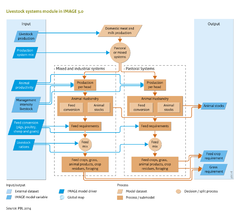Livestock systems: Difference between revisions
Jump to navigation
Jump to search
No edit summary |
Oostenrijr (talk | contribs) No edit summary |
||
| (20 intermediate revisions by 3 users not shown) | |||
| Line 1: | Line 1: | ||
{{ComponentTemplate2 | {{ComponentTemplate2 | ||
|Application=Roads from Rio+20 (2012) project; Global Environmental Outlook - GEO4 project; Millennium Ecosystem Assessment project; OECD Environmental Outlook to 2030 (2008) project; OECD Environmental Outlook to 2050 (2012) | |Application=Roads from Rio+20 (2012) project; Global Environmental Outlook - GEO4 (2007) project; Millennium Ecosystem Assessment - MA (2005) project; OECD Environmental Outlook to 2030 (2008) project; OECD Environmental Outlook to 2050 (2012) project; Global Environmental Outlook - GEO3 (2002) project; EU Resource efficiency (2011) project | ||
|IMAGEComponent= | |IMAGEComponent=Drivers; Agricultural economy; Land-use allocation; Agriculture and land use; Atmospheric composition and climate; Crops and grass; | ||
|Model-Database=MAGNET model; | |||
|KeyReference=Bouwman et al., 2005; | |KeyReference=Bouwman et al., 2005; | ||
|Reference=Bruinsma, 2003; Bouwman et al., 2006; Bouwman et al., 2005; Delgado et al., 1999; Seré and Steinfeld, 1996; FAO, | |Reference=Bruinsma, 2003; Bouwman et al., 2006; Bouwman et al., 2005; Delgado et al., 1999; Seré and Steinfeld, 1996; FAO, 2012a; | ||
|InputVar=Production system mix; Feed conversion; Livestock | |InputVar=Production system mix; Feed conversion; Livestock rations; Livestock production; Management intensity livestock; Animal productivity; | ||
|OutputVar=Animal | |OutputVar=Animal stocks; Feed crop requirement; Grass requirement; | ||
|Description=Food production will have to increase in order to feed the world’s growing population. However, with increasing prosperity and falling production costs, dietary patterns are shifting to include a higher proportion of meat and milk. In the last few decades, traditional mixed farming systems have not been | |Description=Food production will have to increase in order to feed the world’s growing population. However, with increasing prosperity and falling production costs, dietary patterns are shifting to include a higher proportion of meat and milk. In the last few decades, traditional mixed farming systems have not been able to raise production levels sufficiently to meet increasing demand. Consequently, modern livestock production systems are expanding rapidly particularly for poultry and pork, creating growing demand for feed crops. This trend started in high-income countries and is now observed in emerging and developing countries ([[Alexandratos and Bruinsma, 2012]]). | ||
Interactions between crop and livestock production are described in IMAGE and also the consequences of changing practices in livestock farming for production of food crops and grass | Interactions between crop and livestock production are described in the livestock systems module of IMAGE, and also the consequences of changing practices in livestock farming for production of food crops and grass. For this purpose, IMAGE distinguishes pastoral livestock systems, and mixed and landless (industrial) production systems. Pastoral systems are based on grazing ruminants, while mixed and landless systems integrate crop and livestock production in which livestock are fed a mix of crops, crop by-products, grass, fodder and crop residues ([[Bouwman et al., 2005]]; [[Bouwman et al., 2006]]). | ||
Livestock is related to a wide range of the environmental issues, and the consequences of changes in the livestock system can be studied in the | |||
# Expansion of grazing land and particularly arable land for feed crop production, is required to support increasing livestock numbers. According to | Livestock production is related to a wide range of the environmental issues, and the consequences of changes in the livestock system can be studied in the IMAGE framework: | ||
# Large amounts of methane ( | #Expansion of grazing land and particularly arable land for feed crop production, is required to support increasing livestock numbers. According to Bouwman et al. (2005) most arable land expansion is to increase feed production; | ||
# | #Large amounts of methane (CH<sub>4</sub>) emitted by ruminants during enteric fermentation are the second major source of greenhouse gas emissions after CO2; | ||
# Odour nuisance and nitrate leaching to groundwater are major local-scale problems; | #Excreta from all livestock categories is a source of ammonia, methane, nitrous oxide and nitric oxide; | ||
# A significant amount of land used for ruminants grazing is marginal | #Odour nuisance and nitrate leaching to groundwater are major local-scale problems; | ||
#A significant amount of land used for ruminants grazing is marginal, low productive grassland with low carrying capacity and high risk of degradation due to overgrazing, especially in arid and semi-arid regions ([[Seré and Steinfeld, 1996]]; [[Delgado et al., 1999]]). To compensate for productivity losses in these areas, forests may be cleared to expand agricultural land areas. | |||
|ComponentCode=LS | |ComponentCode=LS | ||
|AggregatedComponent=Agriculture and land use | |AggregatedComponent=Agriculture and land use | ||
Revision as of 09:28, 22 July 2014
Parts of Livestock systems
| Component is implemented in: |
| Components: |
| Related IMAGE components |
| Projects/Applications |
|
| Models/Databases |
| Key publications |
| References |
Key policy issues
- What are the impacts of increasing livestock production on land use, greenhouse gases and other emissions to air and surface water?
- How does the use of marginal lands for grazing increase the risk of degradation and loss of productivity, inducing more forest clearing?
